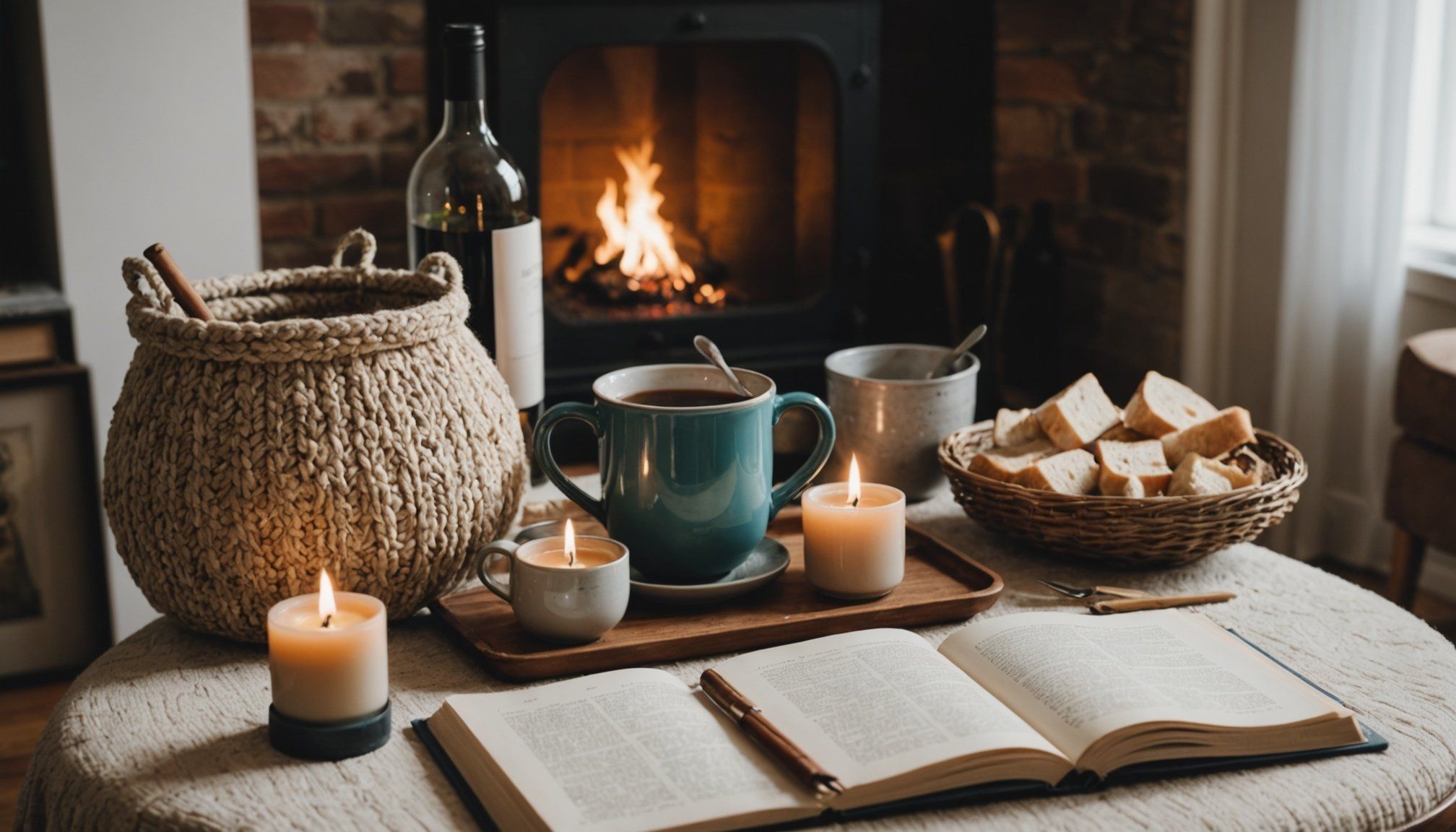Understanding the Importance of a Cozy Sanctuary
Creating a cozy sanctuary can significantly impact mental well-being and stress relief. A comforting environment provides a sense of security, helping to alleviate anxiety and improve mood. Psychologically, when we feel surrounded by comfort, our emotional health benefits, fostering a calmer and more relaxed state.
The connection between physical surroundings and emotional health is profound; our external environment often mirrors our internal states. A well-arranged space, tailored with soothing elements, can decrease stress levels and encourage positive emotions. This is particularly crucial in today’s fast-paced world where personal sanctuaries serve as refuges from daily pressures.
This might interest you : Discover Cost-Effective Methods for Installing Underfloor Heating in Concrete Floors
Furthermore, a cozy sanctuary can serve as a stress relief mechanism, allowing individuals to unwind and recharge. It is essential for enhancing overall mental well-being. Incorporating elements of comfort—be it through tactile materials, calming colors, or ambient lighting—can transform any space into a personal haven. By mindfully creating a sanctuary, we not only create a physical retreat but also cultivate an environment conducive to nurturing our minds and souls. This holistic approach reinforces the key role of our surroundings in supporting our psychological health.
Choosing the Right Décor Style
Exploring various home décor styles is essential when transforming a space into a cozy sanctuary. Each style offers unique elements that contribute to warmth and comfort, essential for personal mental well-being and stress relief. Selecting a décor style involves balancing aesthetic preferences with practical comfort needs.
Also to see : Create an Eco-Friendly Kitchen Haven: Discover the Best Sustainable Design Ideas for Zero-Waste Living
Popular Cozy Décor Styles
Several styles cater to creating an inviting and warm atmosphere. Scandinavian design emphasises simplicity and natural elements, with a neutral palette that encourages tranquility. Bohemian décor combines a mix of colours, textures, and personal elements, creating a lively yet comforting environment. Rustic styles focus on natural materials and earthy tones, promoting a close connection to nature’s warmth.
Blending Personal Aesthetics with Comfort
Infusing personal touches within the chosen style ensures the space feels uniquely yours. Incorporate cherished items that evoke positive memories and emotions, as these contribute to emotional health. Balance aesthetics with comfort by choosing furniture with soft textiles and warm colours that invite relaxation.
Tips for Creating an Inviting Atmosphere
Elevate your space by selecting furniture and accessories that embody warmth, such as plush cushions or soft throws. Incorporating sentimental items adds depth and personal significance, enhancing the emotional connection to your sanctuary. Each step in curating your décor reflects individual style while boosting comfort and well-being.
Materials That Enhance Comfort
In crafting a cozy sanctuary, cozy materials play a pivotal role in enhancing overall comfort. When it comes to textiles, choosing the right fabric is essential. Natural materials such as cotton, wool, and linen are renowned for their breathability and softness, providing a luxurious feel that gently envelops senses. They allow for proper air circulation and help regulate body temperature, making them ideal for a comfortable atmosphere.
Textiles such as plush cushions and soft throws can instantly elevate the comfort level of any room. Cushions filled with down or a high-quality synthetic alternative offer excellent support and resilience. Meanwhile, soft and tactile materials like velvet or chenille introduce an added layer of warmth and sophistication, encouraging relaxation.
On the other hand, synthetic materials can offer versatility and durability, making them a practical choice for high-traffic areas. Fabrics such as microfiber are resilient against wear and tear, while also being easy to clean—an essential feature for maintaining the sanctuary over time. Opt for a blend of natural and synthetic comfort elements to balance aesthetic beauty with practicality, creating a harmonious and inviting space that welcomes rest and rejuvenation.
Color Schemes for a Calming Environment
Creating a calming environment is crucial for enhancing mental well-being and stress relief. A well-chosen color scheme can have a profound impact on mood and emotional health. Understanding color psychology is essential to make informed decisions about your space’s visual ambiance.
How Colors Affect Mood
Colors have the power to evoke emotions. Calming colors, such as soft blues, greens, and pastels, help reduce anxiety and promote tranquility. These hues inspire a sense of peace, making them ideal for spaces intended for relaxation. In contrast, bold and vibrant colors may energize or agitate, potentially disrupting a serene atmosphere.
Ideal Color Palettes for Tranquility
For a soothing environment, select a color palette that harmonizes with your personal style while prioritizing visual harmony. Consider using neutral tones like beige, cream, or soft greys to foster a peaceful setting. These colors act as a foundation, allowing subtle accents to enhance the space without overwhelming.
Incorporating Color Through Accessories
If you’re hesitant to commit to a full palette overhaul, introduce calming colors through accessories. Throw pillows, curtains, or wall art in complementary shades can add depth and warmth. This approach provides flexibility, enabling easy updates to your sanctuary as your style evolves.
The Impact of Lighting on Mood
Lighting plays a pivotal role in shaping the ambiance of a cozy sanctuary. Optimal lighting design can enhance mood and promote overall well-being. Understanding and implementing various light sources creates an inviting and soothing atmosphere.
Types of Lighting for a Cozy Atmosphere
To cultivate warmth, consider ambient light to provide a gentle, all-encompassing glow. Soft, diffused light helps to instill tranquility, while task lighting supports specific activities like reading or focusing. Accent lighting, like uplights or sconces, adds depth and emphasis to particular areas, heightening visual interest.
Tips for Layering Lights
Effective lighting design involves layering different light sources to achieve a harmonious balance. Incorporate a mix of overhead fixtures, lamps, and candles to tailor the environment to your mood or activity. Dimmer switches offer flexibility, allowing adjustment from bright illumination to a soft glow.
The Importance of Natural Light
Natural daylight significantly contributes to mood enhancement. Sunlight boosts serotonin levels, fostering happiness and reducing stress. Where possible, allow natural light to flood your space through unobstructed windows or sheer curtains. Supplement areas with limited daylight with full-spectrum bulbs to mimic sunlight’s restorative effects, ensuring your sanctuary supports mental well-being.
Creating Spaces for Mindfulness and Relaxation
Cultivating mindfulness and relaxation within your home involves designing areas dedicated to self-care. Designating a specific corner or room for these activities can significantly enhance relaxation and mental well-being. Quiet corners equipped with comfortable seating can become sanctuaries for meditation or reading, essential for unwinding from daily stress.
Designating Areas for Self-Care
Establish simple yet effective zones where self-care activities occur. Whether it’s a plush chair by a window for reflection or a calming reading nook, these spaces should evoke tranquility and promote a sense of peace.
Incorporating Relaxation Practices into Daily Life
Embed relaxation practices in your daily routine by seamlessly integrating them into your home’s design. Consider calming activities like yoga or deep breathing sessions. These can be supported by your surroundings with calming scents, visuals, or sounds that magnify the ambiance.
Tips for Creating a Retreat Within Your Home
To create a welcoming retreat, combine comfortable seating with soothing décor. Use soft throws, cushions, and gentle lighting to evoke warmth. Add calming colors and natural elements like small indoor plants to enhance serenity. By thoughtfully crafting these spaces, you offer yourself a dependable refuge from everyday challenges, supporting ongoing emotional resilience.
Adding Personal Touches and Sentimental Value
Infusing personalization into your space adds immeasurable emotional connection. Personal touches make your sanctuary uniquely yours, enhancing comfort and nostalgia. Display cherished photos or mementos that evoke joy, effectively intertwining your personality with décor. Such items not only beautify a space but also serve as constant reminders of treasured experiences.
Creating a gallery wall can be an excellent way to showcase memories. This display not only becomes a decorative focal point but also offers an ongoing narrative of personal joy and life phases. Using various frame styles, sizes, and orientations introduces unique touches that keep the space dynamic and interesting.
While injecting personal elements, it’s wise to leave room for evolving memories and future cherished items. This approach keeps your space flexible and adaptive to new emotional connections. Opt for versatile layouts or multi-functional furniture that can easily accommodate additions over time.
In this manner, your sanctuary remains a living entity, fluid and reflective of your current self, while still honouring past joys. The result is a balanced blend of aesthetics and heartfelt personal storytelling, supporting a calming and comforting environment conducive to mental well-being.
Embracing Nature in Your Sanctuary
Inviting elements of biophilic design into your sanctuary can significantly enhance its atmosphere. Incorporating indoor plants is not only aesthetically pleasing but brings tangible benefits. They improve air quality by absorbing toxins, introducing fresh oxygen, and adding natural beauty, contributing to a serene environment.
Benefits of Indoor Plants for Atmosphere
Indoor plants create a calming ambiance by transforming spaces with life and vibrancy. They act as natural stress relievers and boost mental well-being through their soothing presence, reducing anxiety. Studies suggest a direct link between plant presence and reduced stress, which leads to improved mood.
Incorporating Natural Elements into Design
Natural elements can be subtly woven into home décor for a cohesive, comforting atmosphere. Consider textures like wood, stone, or woven fibers to bring a slice of nature indoors. These materials can be used in furniture, wall art, or decorations, enriching the sanctuary’s connection to the natural world.
Creating a Balanced Indoor-Outdoor Flow
Achieve visual harmony by blending indoor and outdoor spaces. Use low-maintenance plants like succulents or ferns to ensure easy upkeep while maintaining a lively, natural aesthetic. Create a balanced flow by selecting plants and elements that thrive in available light conditions and complement your personal style.
Practices for Sustaining a Cozy Sanctuary
Maintaining a cozy sanctuary involves establishing consistent daily rituals that nurture emotional well-being. Recognising the significance of a tidy, organised space enhances comfort and emotional resilience. Simple habits like tidying up each day help keep your sanctuary inviting and stress-free.
-
Develop rituals that support well-being, such as morning meditation or evening reflection. These routines promote a sense of stability and mental clarity.
-
Introduce small cleaning tasks into your daily schedule to prevent clutter from accumulating. Quick reminders to put away items after use help maintain an orderly atmosphere.
-
Incorporate cues for emotional resilience, such as notes or symbols that inspire and motivate. This reinforces positivity and provides emotional support when needed.
It’s crucial to recognise when your space needs a refresh. Periodically reconfigure furniture or update decor elements to keep the environment inspiring and prevent stagnation. This renewal process can enhance your connection to the sanctuary and provide opportunities to integrate new, cherished moments or items.
By weaving together these practices, you ensure your sanctuary remains a dynamic, comforting retreat that evolves with your emotional needs, supporting overall mental well-being.



